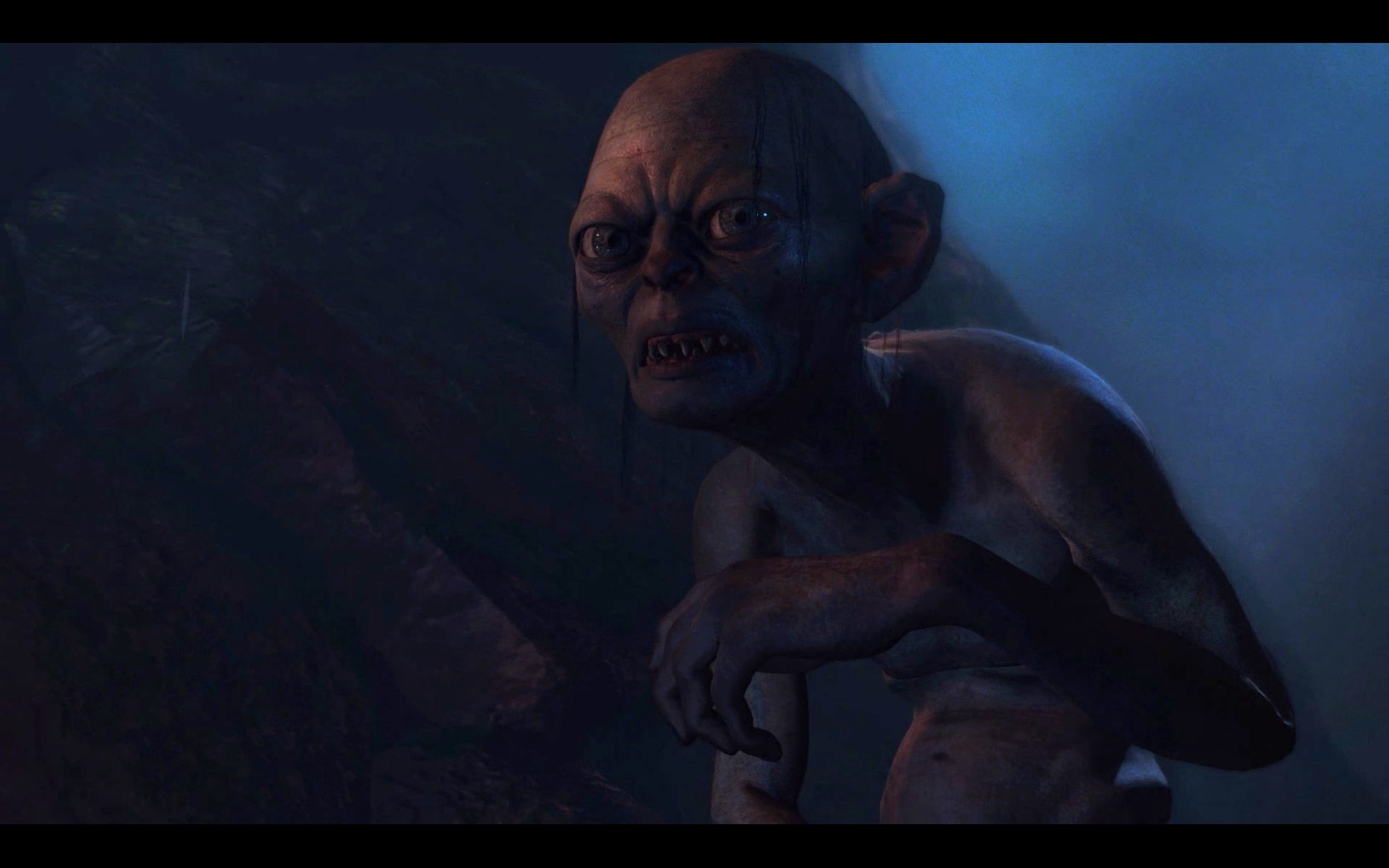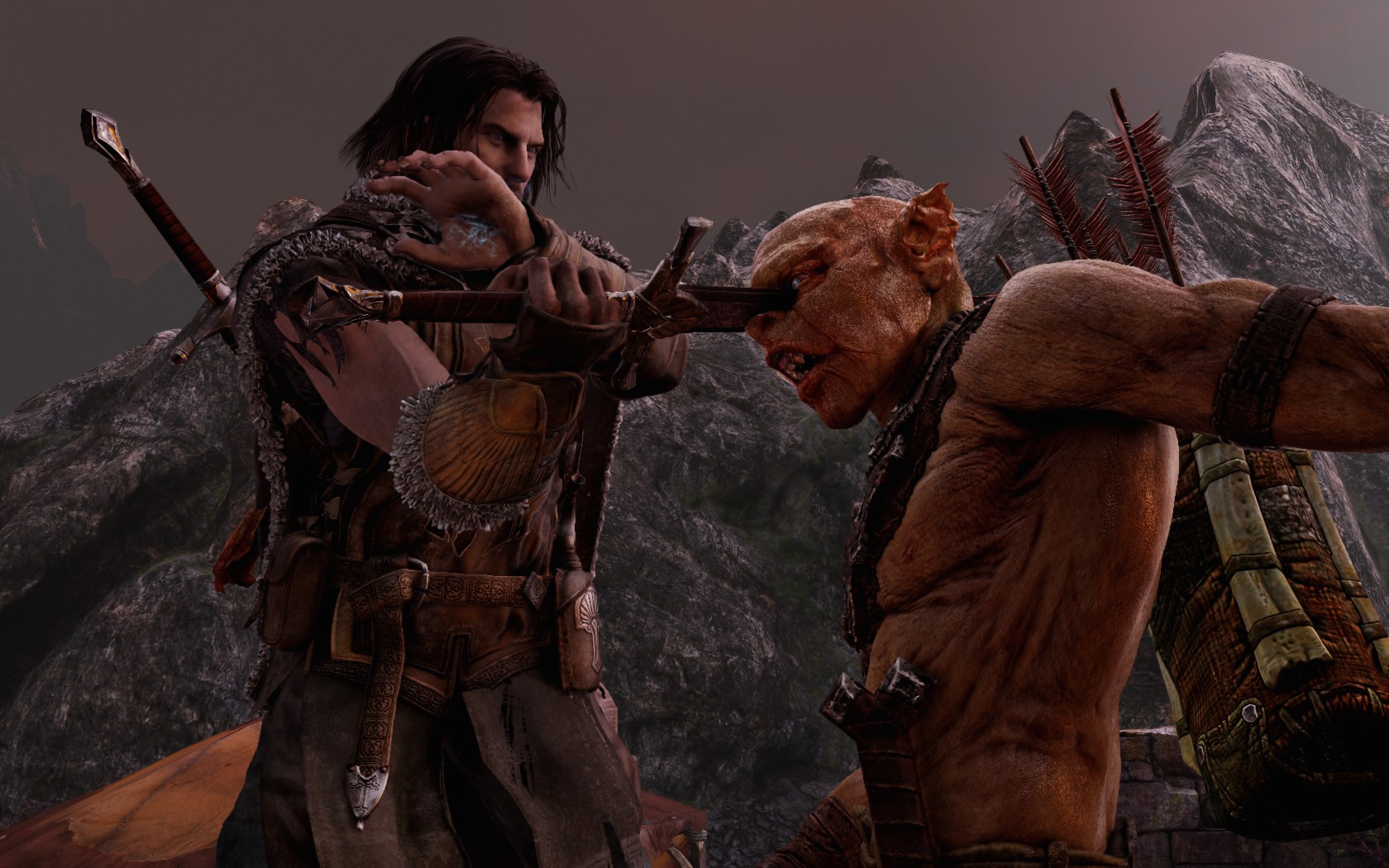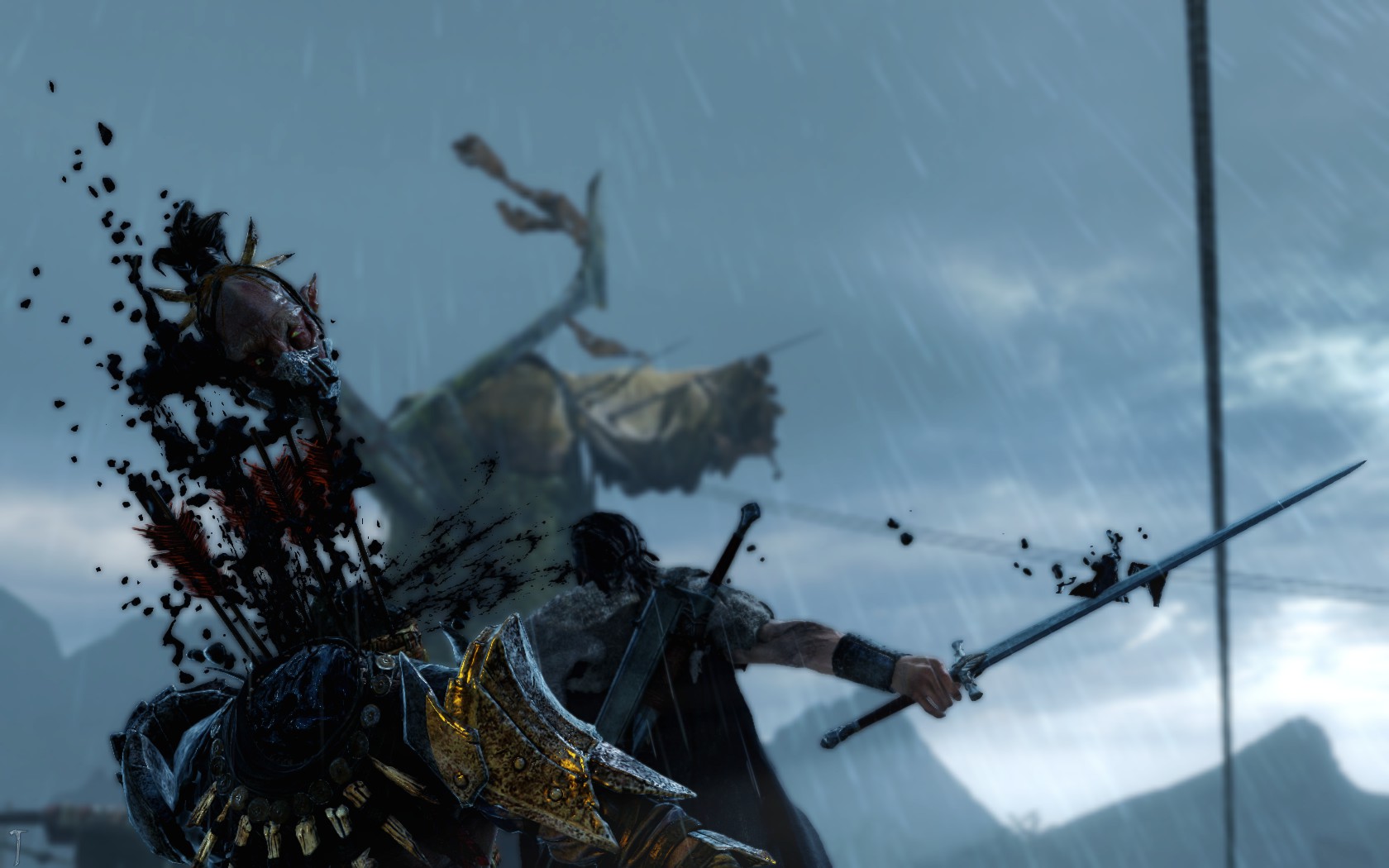Middle Earth: Shadow of Mordor from Monolith Productions was one of my biggest gaming surprises in recent times, when I first saw in game footage it looked ok but didn't really grab me. I think this wasn't helped by a story circulating (later debunked) that suggested the developers had used animation assets from Assassins Creed 2 and so started to sound like a rehash/reworking only interested in aping a popular film/book. It was a few months later when I was watching the developers show off their Nemesis system when I sat up and started taking notice. The game was released in 2014 to the sound of high praise and so when I did pick up my copy it was instantly apparent we had something very special here. All screenshots are my own and many Orcs were slain in the making of this review.
Lore hound
Events of the game bridge the sixty year gap between Lord of the Rings and the Hobbit. You play Talion, a seasoned ranger of the Black Gate; within a few minutes of the opening cut scene you learn that agents of Sauron have murdered you and your family in cold blood. For reasons not apparent at the beginning your mortal body is fused with a wraith and this leaves you in a quasi alive state. While to most you appear flesh and blood the wraith sustains your mortal form and also bestows onto you powerful wraith abilities to complement your own.
If you have any interest in Tolken's universe this game will provide you with some tantalising fan service, from seeing major characters to being able to read about the world in general. One of the stand out performances for me were the sections with Gollum, the voice acting and animations are exemplary and ready gets you suspending your disbelief as you hear Gollum's murderous rasp in your ears. As you wander the land you can pick up artefacts and trinkets that come with voice acted stories from a vast range of settings, these are all optional but if your a fan of the rings films it's really worth finding every one. In addition to this there is a fully fledged index that covers artwork and lore from every corner of the world: this kind of attention to detail shows that the developers really did/do care about the fans and that bodes well for other parts if the game.
Hack and slash
It would be hard not to draw comparisons to the likes of Batman or the Assassins Creed games as far as the combat goes. From the very start the way Talion fights his enemies is fast, brutal and satisfying as hell. Like all good games the player is introduced to the various systems by playing the game and you are quickly given the freedom to roam around the land as you see fit. Yellow symbols on the map indicate a story progressing missions while red show there is some sort of event to interact with pertaining to the Orc armies. There are also various side quests to take on, such as freeing the slaves captured by Sauron or weapon challenges: ones specific to the three weapons Talion carried which are sword, bow and dagger. Most missions are fairly basic in nature, kill ten orcs or rescue a few slaves: usually there bonus objectives encouraging you to kill the enemy with certain skill sets.
If I'm being honest while the environments of SOM look stunning mechanically they are fairly rudimentary. I guess this adds to the desolate feel of Mordor but what's is important is the way Talion moves around his environment which more than makes up for this shortcoming. Not only is the animation smooth and expertly handled but the sheer amount of options Talion has as he leaps and climbs around objects constantly surprised me. Getting this aspect of the game right was crucial to its success and Monolith nailed it: as you stalk your prey and unleash a symphony of bladed death you do feel like a powerful deadly predator.
Costa Del Mordor
As we saw realised in the films, Middle Earth has a vast array of landscapes from grassland, marshes to ancient forests: the desolation of Mordor and surrounding regions are part of this world and are generally seen as an almost lifeless dessert. Here however we do see a different side to Mordor, especially in the second half of the game with trees, lush vegetation and a far more visually pleasing part of Mordor. As I have already mentioned, most of the structures you come across are ruins and orc forts and while these look great they are not very complicated in design.
There is no denying that the game is gorgeous and for every high resolution texture and well places atmospheric lighting system the animation is running along side to deliver a beautiful, brutal and convincing representation of Middle Earth. The adept photo mode is a lovely little addition and it's here you can capture some stunning in game photography, those who know me know I'm always taking screenshots and so this was a real treat: as well as scattered through this review you can see some of the shots I got in the Shooting Gallery.
Secret ingredient
So the base game in Shadow of Mordor (SoM) is pretty damn good: the flow of combat is satisfying, the story is well structured and the whole package comes together very nicely indeed. However there is one core gameplay feature that takes a game that would have ordinarily been very good and catapults it into the stratosphere: the Nemesis system.
When you start the game there is an Orc hierarchy in place with various captains and then right at the top five Warchiefs that rule the roost. Each captain has numerous attributes that make them unique and change how you might approach if you intend on killing them. One for example might have a weakness to being attacked by stealth or being attacked by mounted beasts like Caragors: in these situations you can dispatch a captain in one shot (providing you can get close enough). Captains can also have fears, for example fear of being betrayed or Morgal flies: if you expose them to what they fear the captain will panic and become vulnerable shedding many strengths they have. These attributes are also very well written, many can spell your death if you don't read up on them before you attack, what is a very nice touch is that captains can also change depending on what happens to them. If you set one on fire but then let him escape the next time you face them they may now also fear being burned. You may even see old enemies cropping up you thought you'd killed, now with scars or rope holding their head together as a result of your last fight.
What is also very clever is that literally any Orc can make it big, when one kills you they are instantly given a place as a captain and then must occupy an empty space or fight an existing captain. I love how the names of the orcs also reflect her kind of traits they have and how they look. Nosh the Maggot farm for example may have open wounds with maggots pouring out, the visual diversity seems almost endless. Where the Nemesis system really takes off is how it all interacts with the world you occupy, for example sometimes there will be a feud between two captains: you can go along and make sure one or both don't make it.
Bright eyes
The game is split into two distinct halves, each with their own map and Orc hierarchy. I see the first half as almost a practice hall as in the second half of the game where Talion learns how to 'brand' orcs and thus gain their loyalty. Initially you can only brand orcs by sneaking up or grabbing them in close quarters but soon enough you gain the ability to brand orcs in combat. Once branded a whole other meta game opens up and you can really start to mess with them there War-chiefs. As the mechanic is introduced Talion sneaks around a well guarded camp branding all the elevated archers, you then activate them (which means they drop the act and start attacking your enemies) and watch as the warriors down on the ground get turned into pin cushions within seconds: it really is hard to describe how satisfying this is. You even pick up a skill further on which allows you to explode the heads of all branded orcs in your vicinity.
In terms of captains once you have brought their health down low enough you can also brand these unfortunate souls putting them under your control. You can then tell them to attack another captain, make a death threat (making that captain/War-chief tougher but also yield better rewards) or even infiltrate a War-Chiefs bodyguard. You can see on Saurons army view the interactions and relationships between various orcs and this includes bodyguards. This means if you brand all a War-chiefs protectors and then take them on at any time you hit the activate key and suddenly his captains are hell bent on sending him to Orc heaven. Ending up with five War-chiefs under your influence is one of the main goals of the second half of the game but getting there is so much fun I honestly didn't want it to stop: to this end Monolith have added a battle mode in which you effectively play the nemesis system outside of the games story so if your inclined to murder orcs all day you can do just that.
Beauty and the Beast
Since release SoM has been furnished with two substantial DLC updates, each with its own set of Warchiefs to take on and story elements to work through. The first to drop was Lord of the Hunt, which placed you back in the shoes of Talion. The dwarf you befriend in the main game acts as your guide once more and together you work to take the Beast Warchiefs down. Each one has a different theme to them: one for rides a huge Graug for example, while another lives with an army of Ghuls. The design team have spared no expense with the design of these characters, each with horns, beast trophies and animals pelts covering each one. A nice addition is the ability to ride a new Caragor that can sneak and take enemies down quietly. What is missing is the feeling of progression as all the skills from the main campaign carry over. In addition, weapon skills upgrades are all fully unlocked so this is one less thing to do. Plants can be harvested for health but the survival missions and such don't exist here.
The campaign will last as long as you want it to really with plenty of captains to take down but once you've dispatched the five War-chiefs you are pretty much done here: I would say the average player can expect a few hours minimum and ten or so hours if you do everything.
The second DLC expansion (The Bright Lord) covers the time after Celebrimbor escapes from Sauron with the One Ring and attempts to rescue your ill fated family and punch the Dark Lord's lights out once and for all. As we know from the events of the first game this plan doesn't exactly work out but it's interesting to see how events unfolded and I guess as the promotional bumph suggested you do technically get to fight Sauron. In terms of Gameplay there are a few twists to the skills you use but, like Beast Master, you are effectively the same as Talion when it comes to skills. These two expansions do add plenty to do and offer just enough new bits and bobs to make them worth the time but again how long you spend on them will depend how much you like the game's combat overall.
Is it PC?
Shadow of Mordor is a fantastic example of what a PC game should be when coming out across multiple platforms; after the recent Warner Bros debacle you look back at games like this and know they can deliver the goods. For a start there's an Ultra texture pack designed to run on high end graphics cards, if you can run this without a massive hit to your FPS I would recommend it but honestly, the game does look great in most settings so this is a luxury rather than a necessity.
Of course the game does support controller input but as with most of these type of games I far prefer mouse and keyboard. The reason for this is simply that I love being able to spin my view around at high speed allowing me to gauge which threats I need to dispatch first. This can take a few seconds on controller, ergo it feels slow and clumsy in comparison: however the choice is there and both methods work just fine.
Closing Comments
So Shadow of Mordor was a very pleasant surprise that many didn't see coming, just goes to show you shouldn't make too many assumptions. Does SOM get anything wrong? Well yes and no; after ten or so hours you are effectively doing the same thing as where you first start: activate a tower, kill some orcs, find some plants, assign your new skills and runes, repeat. The true magic of this title is that everything is so well designed with many ways to reach out and change the world. So if you love the combat and the general rhythm of how the game plays then you will not tire easily of playing this game, however after a few hours of decapitating orcs some may have had enough: it all really depends on you the player.
If you enjoy fast, visceral combat and gameplay that really makes you feel powerful you can't really go wrong with SoM. I have seen it a few times on offer now for less than a tenner in Steam sales and if you want an awesome, high quality action game to sink your teeth into for a week you could do a lot worse. I suspect given the critical and financial success of this IP a sequel is being worked on somewhere so here's to that.
















